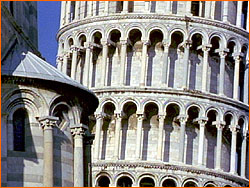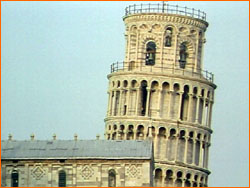
|
 |
 |
Built on the shifting sands of a former estuary, the Leaning Tower of Pisa probably began tilting not long after medieval laborers laid its first foundation stones. In the 800 years since, a bevy of architects, engineers, and self-appointed problem-solvers have bent over backwards trying to slow, halt, or ideally reverse the lean. All efforts have failed - until now. Here we take a look back at those myriad and often misguided attempts, including the most recent and promising of all. 1172 The widow Berta of Bernardo leaves 60 "coins" in her will to the Opera Campanilis Petrarum Sancte Marie to buy stones to build a tower. 1173 On August 9, workers lay the foundation stones for what will become the Leaning Tower of Pisa. Constructed of marble, lime, and stones, the tower is built in a circular ditch about five feet deep, on ground consisting of clay, fine sand, and shells. 1178 When the tower is just over three stories tall, construction stops for unknown reasons. Modern analysis reveals that had work continued before allowing underlying soils to consolidate, the tower would certainly have toppled. 1272 Work recommences nearly a century after the tower was begun, led by Giovanni Di Simone. Initially the tower leans to the north 0.2 degrees off of vertical, but by 1278, when workers reach the seventh cornice and construction stops again (perhaps for military reasons), the tower tilts to the south about one degree, or roughly 2.7 feet. 1360 Over the next 90 years, the inclination increases to about 1.6 degrees. Work on the bell chamber begins about this time. Clearly a southward lean is already apparent, as workers seeking to correct it add six steps from the seventh cornice up to the bell chamber's floor on the south side, while only adding four steps on the north side. The tower is officially completed about 1370.
Workers install the largest of the tower's seven bells, a behemoth weighing three-and-a-half tons. 1817 Two British architects use a plumb line to determine that the foundation's inclination is now about five degrees. 1838 The architect Alessandro Della Gherardesca digs out a walkway called the catino around the base of the tower, to make the formerly buried foundation steps and column plinths visible. 1859 Measurements made by the Frenchman Ruhault de Fleury reveal that Gherardesca's 1838 excavation led to a serious increase in inclination. Since the catino lies below the water table on the south side, the excavation triggered an inrush of water there, along with a possible half a degree increase in the lean. 1911 Precise measurements of the tower's inclination commence using a theodolite. These measurements will be repeated annually from now on, providing a valuable record of tower movements in this century.
Officials add four level stations around the tower's plinth level to help monitor changes in the inclination. 1934 Engineers install a plumb line and a spirit level to measure both the north-south and east-west tilt of the tower. They also drill 361 holes into the masonry foundation and inject 80 tons of grout. The purpose of the grout is to strengthen the masonry, yet the result is a sudden increase in the tower's tilt of 31 arc seconds. (Five arc seconds is equivalent to 1.5 millimeters, or a little over half an inch, of movement at the top of the tower.) 1966 Soil and masonry drilling within and beneath the foundations engenders a modest but not insignificant increase in the tilt of six arc seconds. Continue: 1985 Pisa Panorama | Where it Stands Today | The Galileo Games Rescuing World Monuments | History of Interventions | Resources Teacher's Guide | Transcript | Site Map | Fall of the Leaning Tower Home Editor's Picks | Previous Sites | Join Us/E-mail | TV/Web Schedule About NOVA | Teachers | Site Map | Shop | Jobs | Search | To print PBS Online | NOVA Online | WGBH © | Updated November 2000 |
 Several times during its long and storied history,
the Leaning Tower has come painfully close to
toppling.
Several times during its long and storied history,
the Leaning Tower has come painfully close to
toppling.
 The tower's seven bells were silenced long ago, for
fear their vibrations could trigger a catastrophic
collapse.
The tower's seven bells were silenced long ago, for
fear their vibrations could trigger a catastrophic
collapse.
 Yearly monitoring of the tower's tilt began in 1911,
when officials initiated annual measurements with a
theodolite.
Yearly monitoring of the tower's tilt began in 1911,
when officials initiated annual measurements with a
theodolite.